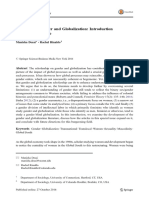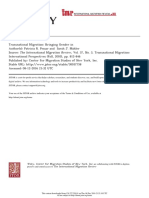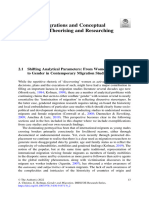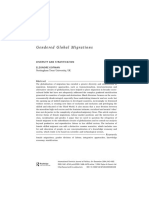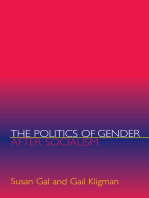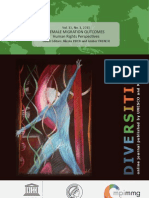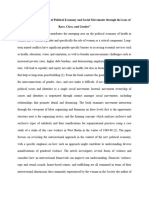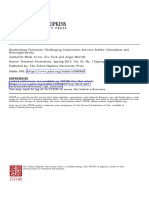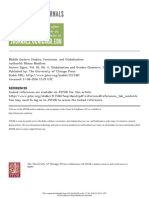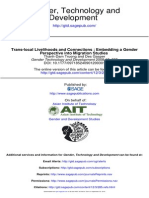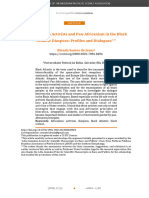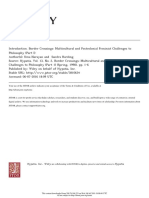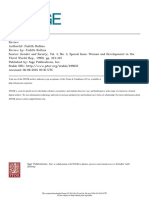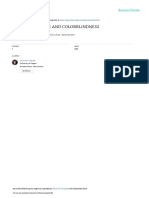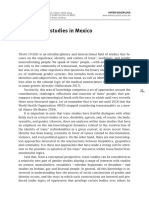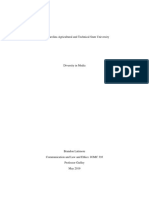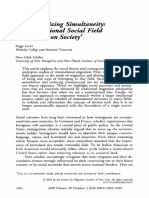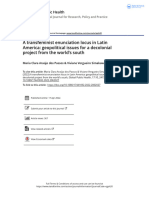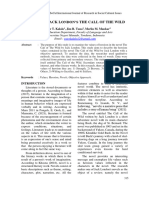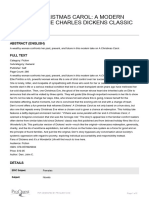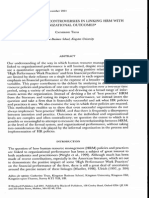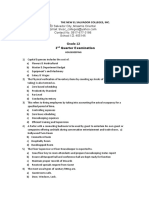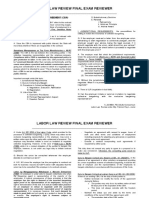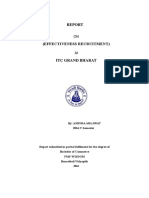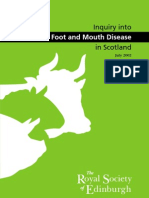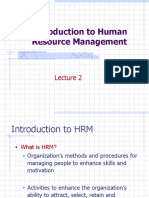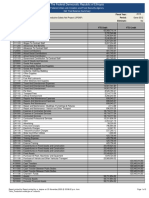Pedraza WomenMigrationSocial 1991
Pedraza WomenMigrationSocial 1991
Uploaded by
siskaprasasti13579Copyright:
Available Formats
Pedraza WomenMigrationSocial 1991
Pedraza WomenMigrationSocial 1991
Uploaded by
siskaprasasti13579Copyright
Available Formats
Share this document
Did you find this document useful?
Is this content inappropriate?
Copyright:
Available Formats
Pedraza WomenMigrationSocial 1991
Pedraza WomenMigrationSocial 1991
Uploaded by
siskaprasasti13579Copyright:
Available Formats
Women and Migration: The Social Consequences of Gender
Author(s): Silvia Pedraza
Source: Annual Review of Sociology , 1991, Vol. 17 (1991), pp. 303-325
Published by: Annual Reviews
Stable URL: https://www.jstor.org/stable/2083345
REFERENCES
Linked references are available on JSTOR for this article:
https://www.jstor.org/stable/2083345?seq=1&cid=pdf-
reference#references_tab_contents
You may need to log in to JSTOR to access the linked references.
JSTOR is a not-for-profit service that helps scholars, researchers, and students discover, use, and build upon a wide
range of content in a trusted digital archive. We use information technology and tools to increase productivity and
facilitate new forms of scholarship. For more information about JSTOR, please contact support@jstor.org.
Your use of the JSTOR archive indicates your acceptance of the Terms & Conditions of Use, available at
https://about.jstor.org/terms
Annual Reviews is collaborating with JSTOR to digitize, preserve and extend access to Annual
Review of Sociology
This content downloaded from
182.255.0.242 on Sat, 27 Apr 2024 16:22:22 +00:00
All use subject to https://about.jstor.org/terms
Annu. Rev. Sociol. 1991. 17:303-25
Copyright ? 1991 by Annual Reviews Inc. All rights reserved
WOMEN AND MIGRATION: The
Social Consequences of Gender
Silvia Pedraza
Department of Sociology and Program in American Culture, University of Michigan,
Ann Arbor, Michigan 48109
KEY WORDS: household decision-making, demographic composition, micro and macro
analysis, labor force participation, occupational concentration, family roles
Abstract
This paper reviews the literature on the neglected role of women in migration.
It argues that focusing on gender and the family can provide the necessary
linkage of micro and macro levels of analyses. Striving to contribute to a
gendered understanding of the social process of migration, the review orga-
nizes the literature along these major issues: How is gender related to the
decision to migrate-i.e. what are the causes and consequences of female or
male-dominated flows of migration? What are the patterns of labor market
incorporation of women immigrants-i.e. what accounts for their participa-
tion in the labor force and their occupational concentration? What is the
relationship of the public and the private-i.e. what is the impact of work
roles on family roles and of the experience of migration on the immigrants
themselves? Throughout, the necessity to understand how ethnicity, class,
and gender interact in the process of migration and settlement is stressed.
INTRODUCTION
Despite the overwhelming presence of women in migration flows, until
recently the role of women in migration had been totally neglected. As
Houstoun et al (1984:908) have pointed out, the pervasive assumption that the
international migrant is a young, economically motivated male has over-
303
0360-0572/91/08 15-0303$02.00
This content downloaded from
182.255.0.242 on Sat, 27 Apr 2024 16:22:22 +00:00
All use subject to https://about.jstor.org/terms
304 PEDRAZA
shadowed the reality of migration streams that were dominated by women:
"Ironically, few immigration researchers (and even fewer policy makers) are
aware that legal immigration to the United States still very much the largest
of all international flows has been dominated by females for the last half-
century." For the United States a crossover in sex differentials in migration
occurred in 1930, after which women annually outnumbered men (Houstoun
et al 1984: Table 1). As demographers, Houstoun et al highlighted this glaring
neglect as it appears in the discipline of sociology. For the field of history,
Maxine Seller (1975:197) emphasized it when she pointed out that while
much had been written about the achievements of the men who came to the
United States from Southern and Eastern Europe at the turn of the century,
much less appeared about the experiences of the immigrant women of this
period. She attributed this neglect to the persistence of negative stereotypes
which made it appear that women did little worth writing about. After these
various calls, more attention was paid to women and migration (cf Simon &
Brettell 1986). Now, the topic has mushroomed. Yet, while we know a great
deal about the impact of women's position on other social outcomes such as
fertility (cf Mason 1987), we have yet to develop a truly gendered understand-
ing of the causes, processes, and consequences of migration. Paying attention
to the relationship between women's social position and migration will help
fill the void regarding our knowledge of women as immigrants and contribute
to a greater understanding of the lives of women. It will also elucidate those
aspects of the process of migration that were neglected by the exclusive focus
on men.
The study of immigration is by its very nature interdisciplinary. A natural
division of labor has arisen whereby sociologists attend most to contemporary
immigration flows (the Latin American and Asian), historians are concerned
with past flows (the Southern and Eastern European), and anthropologists
relate to the impact of emigration and return on the sending communities in
underdeveloped nations. Without seeking to be exhaustive, this review draws
upon research from these various disciplines and attempts to organize the
literature to show how ethnicity, class, and gender interact in the process of
migration and settlement.
As we try to bring women into the study of migration, it is worth consider-
ing Judith Stacey & Barrie Thorne's (1985) assessment of how different
disciplines have incorporated gender. They stress that anthropology, history
and literature have all been more profoundly transformed than sociology,
while psychology, economics, and political science have all resisted
transformation. Bringing women into the humanities and the social sciences
takes place in stages: first, by filling in the gaps in knowledge resulting from
their absence; second, by transforming the conceptual and theoretical
frameworks of their disciplines (see also Louise Tilly 1989).
This content downloaded from
182.255.0.242 on Sat, 27 Apr 2024 16:22:22 +00:00
All use subject to https://about.jstor.org/terms
WOMEN AND MIGRATION 305
Traditionally, history chronicled the world of men in public places-in
work, organizations, church, politics. In this history, women were included
only when they left home and entered the labor force, took part in strikes,
joined labor unions, or worked for suffrage, since only then did their activities
become public and accessible to traditional research methodology (cf Wein-
berg, in press). As Stacey & Thorne emphasized, feminist historians shifted
the focus of research by placing women at the center and writing the history of
the private sphere and of the relationship between the public and the private.
Likewise, literature was transformed by the inclusion of women and ethnic
writers, changing the canon that defined the field. Anthropology has been the
most deeply transformed by feminist contributions because the analysis of
kinship and the sexual division of labor has always been its very core (cf
Yanagisako & Collier 1987). Thus, feminist thinking matured and went from
woman-centered analyses to providing what Stacey & Thorne (1985:305-6)
call a "gendered" understanding of all aspects of human culture-one that
traces "the significance of gender organization and relations in all institutions
and in shaping men's as well as women's lives."
Within sociology, by contrast, much research on women has filled in gaps
and yielded new insights and directions, but the field itself has undergone
little transformation, as a truly gendered understanding of most topics has not
been achieved. Traditionally, sociology was neither totally male-defined, as
history or literature, nor basically gender-sensitive, as anthropology. Thus,
Stacey & Thorne judged that the feminist contributions to sociology were
contained by the delimiting capacity of functionalism to explain male-female
differences; of empiricism to treat gender as a variable, rather than as a central
theoretical concept; of Marxist sociology to ghettoize it; and by the un-
derdevelopment of feminist theory itself.
Striving to contribute to a gendered understanding of the social process of
migration, I have organized the various strands of this literature according to
the following major issues: How is gender related to the decision to migrate-
i.e. what are the causes and consequences of female or male-dominated flows
of migration? What are the patterns of labor market incorporation of women
immigrants-i.e. what accounts for their participation in the labor force and
their occupational concentration? What is the the relationship of the public
and the private i.e. what is the impact of work roles on family roles and of
the experience of migration on the immigrants themselves?
THE DECISION TO MIGRATE
Micro and Macro Linkages
The underlying assumption in studies of migration has been the male pau-
per a single or married male who looks forward to amassing capital with
This content downloaded from
182.255.0.242 on Sat, 27 Apr 2024 16:22:22 +00:00
All use subject to https://about.jstor.org/terms
306 PEDRAZA
which to return to his native country. Thus, the corollary assumption has been
that it is males who typically make the decision to migrate and that females
follow. As Everett Lee (1966:51) most fully expressed it in his seminal
"push" and "pull" theory of migration, "Indeed not all persons who migrate
reach that decision themselves. Children are carried along by their parents,
willy-nilly, and wives accompany their husbands though it tears them away
from environments they love." Houstoun et al (1984:919) also stressed that,
with the exception of domestics, women "generally migrate to create or
reunite a family;" they saw female-dominated flows of migration as secondary
movements generated by the original migration of economically motivated
young males. While women do migrate to join men and to create families (cf
Watts 1983, Tyree & Donato 1986), this hardly constitutes an explanation for
the fact that "during the last half-century, the traditional working-age immi-
grant male has accounted for only a third of all immigration to the United
States" (Houstoun et al 1984:913). Katharine Donato & Andrea Tyree (1986)
analyzed the sex ratios of immigrants from over a hundred nations and
examined the impact of American immigration law as well as the characteris-
tics of migrants and their countries of origin. They concluded that, when
viewed on the whole, family reunification accounted for the sex distribution
of US immigration. In addition, the availability of jobs in the expanding
health care industry also played a part. When viewed in the detail of national
origins, however, a more complicated picture emerged with factors such as
the presence of a US military base and the country's socioeconomic con-
ditions also playing a role.
Contrary to the manner in which the topic of women is usually treated in
sociology, a truly gendered understanding of the social process of migration is
provided by Sherri Grasmuck & Patricia Pessar's Between Two Islands (in
press). Their analysis of contemporary migration from the Dominican
Republic to New York City (the two islands) entailed and benefitted from the
collaboration of a sociologist and an anthropologist, respectively. By focusing
on the household and the relations between its members as these affect the
decision to migrate, Grasmuck & Pessar's analysis also provided a much-
needed link between the traditional micro explanations of migration and the
recent macro explanations of it (cf Pedraza-Bailey 1990, Boyd 1989).
In sociology, the traditional, individual micro approach was best developed
by Lee's (1966:50) theory which focused on the individual migrant's decision
to migrate-the "push" and "pull" factors that "hold and attract or repel
people," as well as the intervening obstacles (distance, physical barriers,
immigration laws, cost), the influence of personal traits (stage in the life
cycle, contact with earlier migrants), and the effect of transitions (marriage or
retirement).
The more recent approach to the study of immigration focused on struc-
This content downloaded from
182.255.0.242 on Sat, 27 Apr 2024 16:22:22 +00:00
All use subject to https://about.jstor.org/terms
WOMEN AND MIGRATION 307
tural-level variables. The link between migration and world patterns of un-
equal development increasingly became evident. North America remained the
magnet that yesterday as well as today attracts the world's poor. In Western
Europe the periphery countries of Spain, Italy, Greece, and Turkey became
suppliers of labor to the industrialized core countries of France, Germany, and
Switzerland. Hence, a new set of structural, macro perspectives emerged. The
structural perspective argued that a system of economic migration had de-
veloped from the flow of labor between developed and underdeveloped
nations due to the functions that this system of labor migration performed.
Arguing independently but in a similar vein, Manuel Castells (1975), Michael
Burawoy (1976), and Alejandro Portes (1978) agreed that immigrant labor
had structural causes and performed important functions for the developed
capitalist nation that received it. While replacement labor the migration of
low-skilled labor-provided countries such as the United States or France
with a dependable source of cheap labor, it also provided countries such as
Mexico or Turkey with a "safety valve" as emigration became the solution to
their inability to satisfy the needs of their poor and lower-middle classes.
Silvia Pedraza-Bailey (1985) sought to extend the structuralist approach to
explain refugee flows as involving political functions that can also generate a
system of political migration between sending and receiving societies, such as
Cuba and the United States. Maria Patricia Fernandez-Kelly (1983) demon-
strated yet another linkage that migration provides between developed and
underdeveloped capitalist nations with her in-depth study of the maquiladoras
in the US-Mexican border region. The maquiladoras are manufacturing
industries that resulted from the Mexican border industrialization program,
whose expressed intent was to provide employment opportunities for Mex-
icans to help curtail undocumented migration. Fernandez-Kelly (1983:209)
also emphasized that the most striking feature of this development was "its
gender-specific nature. Although the majority of undocumented aliens work-
ing the fields of the U.S. Southwest continue to be male, 85 percent of those
working in the export-manufacturing plants along the Mexican border are
female." Saskia Sassen-Koob (1984) sought to extend the structuralist
approach to incorporate the migration of women by noting the intrinsic
relationship between the recruitment of women into the new manufacturing
and service jobs generated by export-led manufacturing in several Caribbean
and Asian countries and the employment of immigrant women in highly
industrialized countries, particularly in major cities which have undergone the
shift to a service economy.
The recent macro approach was an important corrective to the traditional,
micro approach which failed to take into account that since the advent of the
Industrial Revolution all individual decisions to move have resulted in migra-
tion flows that moved in only one direction. The danger of the structural
This content downloaded from
182.255.0.242 on Sat, 27 Apr 2024 16:22:22 +00:00
All use subject to https://about.jstor.org/terms
308 PEDRAZA
emphasis, however, lies in its tendency to obliterate people, to lose sight of
the individual migrants who do make decisions. The theoretical and empirical
challenge now facing immigration research inheres in its capacity to capture
both individuals as agents, and social structure as delimiting and enabling.
We need to consider the plight of individuals, their propensity to move, and
the nature of the decisions they make. We also need to consider the larger
social structures within which that individual plight exists and those decisions
are made. Such a link between micro and macro levels of analysis is provided
by Massey et al (1987) in their analysis of Mexican migration to the United
States. They showed that international migration originates historically in
transformations of social and economic structures in sending and receiving
societies, but that once begun migrants' social networks grow and develop.
These networks support and channel migration on a continuously widening
scale. Thus, the migration that was initially propelled by an external, structur-
al dynamic and logic increasingly acquires an internal dynamic and logic of its
own. In this way, migration comes to fuel itself. As families make migration
part of their survival strategies and use it during stages of the life cycle when
dependence is greatest, individual motivations, household strategies, and
community structures are altered by migration, making further migration
more likely.
As Boyd pointed out, however, to date much of the recent research on
networks has been indifferent to gender, to the fact that "the division of
labor the structured activities in a society are gendered" (1989:656). Gras-
muck & Pessar's analysis (in press) also focused on social networks and
households as the link between micro and macro levels of analysis; they
demonstrated that gender is central to household decision-making. Therefore,
it is central to the decision to migrate, as a family strategy intended to meet
the challenges that accompany underdevelopment and economic and political
transformation in the Third World. As Grasmuck & Pessar emphasized, the
household is the social unit that makes decisions as to whether migration will
take place, who in the family will migrate, what resources will be allocated to
the migration, what remittances or household members can be expected to
return, and whether the migration will be temporary or permanent. All of
these decisions are guided by normatively prescribed kinship and gender roles
as well as by the hierarchy of power within the household (cf Hondagneu-
Sotelo, in press).
Both the studies of Massey et al and of Grasmuck & Pessar have the further
virtue of a solid interdisciplinary research design. They merge the methodolo-
gy of sociology (a survey) with that of anthropology (ethnography) in their
research, thereby creating an ethnosurvey that overcomes the shortcomings of
each (cf Massey et al 1987:11-13). In addition, within the country from
which the migration originated (Mexico, Dominican Republic), they chose to
This content downloaded from
182.255.0.242 on Sat, 27 Apr 2024 16:22:22 +00:00
All use subject to https://about.jstor.org/terms
WOMEN AND MIGRATION 309
study, through both methods, very different types of communities:
al rural town, a commercialized agricultural community, an industrial town,
and a city. This diversity best allowed an assessment of the social, economic,
and cultural forces that contributed to the migration through comparisons of
migrant with nonmigrant households. In the area of destination (California,
New York City), drawing a representative sample of all immigrants was not
possible, but snowball sampling led to the inclusion of both documented and
undocumented immigrants. It is worth highlighting the methodology of both
these studies because, unfortunately, there is a real methodological problem
in this area of research. A number of very interesting studies of women
immigrants collected in-depth interviews but from too small or unrepresenta-
tive a sample, making their insightful conclusions less than precise and firm.
Focusing on the household as the unit of analysis, Grasmuck & Pessar
analyzed the household political economy as well as the power relations
among its members that resulted in migration as a household strategy issuing
from structural necessity. In the Dominican Republic, the transition from
subsistence farming (based mostly on household labor) to commercial farm-
ing (based on wage labor) disrupted the traditional family relations. Whereas
earlier many sons had been an asset, they were now an obstacle, a problem
that was solved by sponsoring a son's emigration. This change in the political
economy of the area also held profound consequences for the women, since
the more successful households with status aspirations were able to gain in
status by freeing their women from agricultural work. However, the women
then ceased to contribute economically to the family and also became totally
dependent on their husbands. One way to solve the contradiction between
local gender and class norms, on the one hand, and the goal of the migration
strategy, on the other, was to sponsor the wife's emigration to the United
States, where there was less resistance to women working outside the house-
hold for wages. For the women themselves, the act of emigrating also became
a way of escaping total dependence on their husbands. Thus, both sons and
wives undertook the decision to migrate because of the gains in personal
autonomy they anticipated, reducing the patriarchal control of fathers and
husbands. In her participant observation study of Mexican undocumented
women, Pierrette Hondagneu-Sotelo (in press) also found that while the
decision to migrate may constitute a joint family strategy, the actual process
of decision-making and the staggered departures of family members betray
enormous interpersonal conflict.
As Pessar (1986:276) pointed out, "In contrast to men, migration does not
rupture the social sphere in which women are self-actualized," that of the
household and family, Hence, not only was gender at the center of the
decision to emigrate it was also at the center of the reluctance to return, as
women struggled to maintain the gains that migration and employment had
This content downloaded from
182.255.0.242 on Sat, 27 Apr 2024 16:22:22 +00:00
All use subject to https://about.jstor.org/terms
310 PEDRAZA
brought them. Grasmuck & Pessar found that while men were eager to return,
a desire expressed in their frugal, austere living to accumulate savings,
women tended to postpone or avoid return because they realized it would
entail their retirement from work and the loss of their new-found freedoms.
As a result, a struggle developed over finances and return that revolved
around the traditional definitions of gender roles and privileges which the
migration itself had challenged and which many men sought to regain by
returning home. Many women spent large amounts of money on expensive,
durable goods, such as a home and home furnishings, serving to root the
family securely in the United States and to deplete the funds necessary to
relocate. Through their use of interdisciplinary methods and understandings,
Grasmuck & Pessar reached a depth of analysis each method alone could not
have sounded and produced a truly gendered understanding of the social
process of migration.
The Demographic Composition of the Migration Flow
Emigration is a process experienced differently by women and men; hence, it
can be sex-selective. As Joy Parr (1987:530) underlined, "emigration can be
the product of sex imbalances; it also forms them, both in the old country and
the new." Examining international migration patterns, we can see that not
only have women comprised at least half of recent immigrants to the United
States, they have also predominated among immigrants to Argentina and
Israel and now constitute an increasing share of migrants in areas such as
West Africa and the Persian Gulf states (Tyree & Donato 1986). Examining
internal migration patterns, we can see that whereas in Africa men predomi-
nate in migration to the cities and women remain in rural areas to farm the
land, in Latin America, the Caribbean, and Philippines, most migrants to
cities are women. In South Asia men outnumber women substantially in cities
(see Fernandez-Kelly 1983, Reiff et al 1983, Gabaccia 1987, Khoo et al
1984, Lee 1989, Hojman 1989, Gugler 1989). These contrasts are largely due
to the nature of the existing land tenure and agricultural production arrange-
ments. Moreover, profound change can take place over time, as in sub-
Saharan Africa where, in Joseph Gugler's (1989) analysis "Women stay on
the farm no more." This change resulted from the increased opportunities in
cities-in income and employment for women together with medical care and
education for children-at the same time that agriculture became less profit-
able as a result of state pricing policy for cash crops. Moreover, government
policy can create imbalanced migration flows by legally restricting the migra-
tion of males or females, as in Lesotho. Wilkinson (1983) showed the
consequences for the women of Lesotho from neighboring South Africa's
influx control laws that excluded women. As a result, a male-dominated flow
of migrant labor to work in the mines crossed the international boundary of
This content downloaded from
182.255.0.242 on Sat, 27 Apr 2024 16:22:22 +00:00
All use subject to https://about.jstor.org/terms
WOMEN AND MIGRATION 311
Lesotho and also generated a female-dominated internal flow of migration to
the cities of Lesotho where phenomenal sex imbalances occurred.
MALE EMIGRATION Flows of migration that are dominated by men require
that we consider "the woman's side" when the women themselves are left
behind in the communities. Caroline Brettell (1988) analyzed the impact of
longstanding male emigration from Portugal to Brazil and Spain in the late
nineteenth and twentieth centuries. She used the household data kept by the
parish priest of Santa Eulalia de Lanheses in Portugal to assess the impact of
the emigration on the matricentric characteristics of the way of life in this
area, particularly the formation and structure of households. Households
adjusted to the centuries of absence of men by becoming female-headed, often
extended three-generation households, and, contrary to the Mediterranean
pattern, patriuxorilocal, since grooms often moved in with the wife's family.
Male migration also affected the lives of women by promoting a delayed age
at marriage and high rates of spinsterhood as well as illegitimacy, both of
which bound the women more firmly to their families of origin.
Barbara Engel (1986) also attended to "the woman's side" as she analyzed
the impact, on the village, the family, and the women left behind, of the
emigration of men from the villages of Kostroma province to the cities of
Russia in the late nineteenth century. As peasants, the family was an eco-
nomic unit of production, not just of consumption, and marriage to a village
girl tied the young man who left more firmly to the family-economy as the
wife continued to work in agriculture, in his place, and to live with her
in-laws. Families thus placed greater constraints on women's migration than
they did on men's; hence, few women emigrated. As a family strategy the
out-migration of men that retained wives laboring in the village had many
advantages. Marrying a man who worked elsewhere made women's lives
more difficult in some ways as it tied them tighter to the soil and increased
their burdens, but it also made women's lives easier in other ways as they
endured childbirth less often and their children survived more often due to
better health and nutrition. Moreover, the marriage relation itself may well
have benefitted as women acquired more control over their lives and a
measure of dignity while the marriage became more of a partnership.
FEMALE EMIGRATION Flows of migration that are dominated by women are
often neglected, yet it is quite common for refugee flows to be initially
dominated by women and children, as in the early years of both the Cuban and
Indochinese exodus to the United States an imbalance that altered over time
(Pedraza-Bailey 1985, Rumbaut 1989). Refugees initially lack a motivation to
settle elsewhere and only when they come to perceive the existing political
situation as intolerable do they feel forced to leave, a choice they would rather
This content downloaded from
182.255.0.242 on Sat, 27 Apr 2024 16:22:22 +00:00
All use subject to https://about.jstor.org/terms
312 PEDRAZA
not have made (cf Stein 1981:322, Rose 1981:8). Thus, refugees often suffer
from the mentality of those caught in a sinking ship-to reach safety, women
and children first. Secondary migrations of men, who move to reunite fami-
lies, are then generated.
Ultimately, the demographic composition of migration flows is important
not only because its causes are various but also because of its consequences.
In his comparative analysis of Italian and Jewish mobility in New York at the
turn of the century, Thomas Kessner (1977) underscored that their patterns of
social mobility and attainment depended on the varying composition of the
migration flows. Newcomers that arrive as temporary migrants as "birds of
passage," in Michael Piore's (1979) phrase work with the goal to return
home, tolerating the most abysmal working conditions to accumulate capital
for their investments back home. By contrast, permanent immigrants must
make their future in the new land and cannot tolerate abysmal working
conditions by thinking they are temporary. Thus, they seek to attain social
mobility in the new society, taking greater risks and making more long-term
investments, such as setting up family businesses (Piore 1979:55-68). The
two types of migration are reflected in the demographic composition of the
flows. Flows of temporary migrants, such as the Italian, are by and large
nonfamily movements of males in the productive years who intend to make
money and return home. By contrast, flows of permanent immigrants, such as
the Jewish, are characterized by the migration of families who intend to
remake their lives and homes (Kessner 1977).
Focusing on both the causes and consequences of a female-dominated flow
of migration, Hsia Diner (1983) studied Irish immigrant women in the
nineteenth century. The Irish migration was pushed by conditions that pre-
vailed throughout much of Europe then poverty, landlessness, and the social
and economic dislocations that accompanied the transition from an agrarian
feudal society to an industrial, capitalist society (cf Bodnar 1985). These
conditions were exacerbated by the famine of the late 1840s. Coupled with the
Irish system of single inheritance and single dowry, Ireland increasingly
became the home of the unmarried and the late married. More than half of the
Irish immigrants to the United States were women, and as the century wore on
the migration became basically a female mass movement. As Diner (1983:4)
demonstrated, the root cause was that social and economic conditions in
Ireland were such that "Ireland became a country that held out fewer and
fewer attractions to women." Women had few realistic chances for marriage
or employment; to attain either most had to turn their backs on the land of
their birth. Hence, not just famine and poverty but what Jackson (1984:1007-
8) called "the interlocking relationship of land-family-marriage" caused the
preponderance of women in the migration. As a consequence of land scarcity,
both arranged marriages and the practice of dowries spread, and celibacy and
This content downloaded from
182.255.0.242 on Sat, 27 Apr 2024 16:22:22 +00:00
All use subject to https://about.jstor.org/terms
WOMEN AND MIGRATION 313
late marriages rose. One escape from family and spinsterhood was for
to join a religious order; another was emigration.
Consequently, the Irish exodus to the United States was predominantly
female and young, a migration stream mostly composed of single persons.
The usual kin chain migration became a female migratory chain in which
women brought over other women sisters, mothers, nieces, aunts, friends.
As will be seen later, the major consequence of the predominantly female and
single nature of the migration was that Irish women were able over-
whelmingly to enter domestic service.
THE INCORPORATION OF WOMEN
Labor Force Participation
That immigration has a decided impact on the labor force participatio
women is a central fact of immigration research. It is also one of the
issues in studies of Cuban immigrants (Perez 1988). In contrast to the very
low rates of labor force participation of women in Cuba prior to the revolu-
tion, and of Mexican and Puerto Rican women in the United States at present,
Cuban women who emigrated to the United States have had a very high rate of
labor force participation (Sullivan 1984). Yolanda Prieto (1987) interviewed a
sample of Cuban-born women in New Jersey, a more working-class commu-
nity than Miami, and concluded that the major determinant of the massive
entrance of the women into the labor force was their original social class (cf
Garcia-Castro 1986). These women were middle-class either in their origin
or, if working class, in their aspirations. Achieving the upward mobility of the
Cuban family in the United States made women's work necessary and broke
with the traditional Cuban notion that a woman's place is in the home,
justifying the massive entrance of women into the labor force.
Indeed, Cuban women overwhelmingly saw work as the opportunity to
help the family, rather than as an opportunity for self-actualization. Thus,
Myra Max Ferree (1979:48) wrote that Cuban women were an example of
employment without liberation. Cubans had apparently stretched the tradi-
tional view of women existing for the family to include employment as part of
that role, while implying no necessary change in values. Ferree emphasized
that the seeming ease with which this occurred ought to cast doubt on cultural
explanations for the low labor force participation of Hispanic women (cf
Santana-Cooney & Ortiz 1983, Reimers 1985). However, Lisandro Perez
(1988) underscored the need to look at generational differences. The first
generation reared in the traditional culture may well view employment as
instrumental, but the second generation, more American, might hold a differ
ent set of attitudes. Perez's (1986) research also showed that whereas Cubans
have a relatively high family income, they do not compare so favorably in
This content downloaded from
182.255.0.242 on Sat, 27 Apr 2024 16:22:22 +00:00
All use subject to https://about.jstor.org/terms
314 PEDRAZA
terms of individual income, pointing to the importance of the dual-income
family in the formation of what has come to be known as the Cuban "success
story."
Numerous research studies have also examined the labor market outcomes
of immigrant women-the occupations and income they attained and the
disadvantages reflected in different "payoffs" to their characteristics (e.g.
Tienda et al 1984, Sullivan 1984, Boyd 1984, Evans 1984, Lichter 1983).
Most of these studies rely on large data sets (such as the censuses or the
National Longitudinal Survey), and quantitative analyses, rendering their
results persuasive. But, by and large, they suffer from the problem Stacey &
Thorne identified as the way sociology has incorporated women: they treat
gender as a variable, rather than as a central theoretical principle. Moreover,
many of these studies tend to make gross comparisons between all immigrants
vs all native-born (e.g. Tienda et al 1984, Maxwell 1988, Morrison & Lichter
1988) that fail to take into account the substantial variation in the causes and
consequences of the incorporation of different immigrant groups (e.g. Cubans
vs Mexicans) and of the native-born (e.g. whites vs blacks).
Occupational Concentration
The concentration of certain immigrant or ethnic groups in particular types of
occupations is a central fact that a theory of the incorporation of racial or
ethnic groups needs to explain (cf Feagin 1978). Like men, immigrant women
became occupationally concentrated but along a much smaller spectrum of
choices. Although immigrant women can be found doing the hard labor of
construction in some societies (see Lee 1989), most of them cluster in just a
few occupations. They become domestic servants, work for the garment
industry, donate their labor to family enterprises, or most recently, work in
highly skilled service occupations, such as nursing.
DOMESTIC SERVICE As Mary Garcia-Castro (1986) emphasized, migration
has different meanings for married women with or without children than for
single women. Diner specified that the major consequence of the pre-
dominantly female and single nature of the Irish migration was that Irish
women overwhelmingly entered domestic service, an occupation in which
there was a "labor vacuum" because others did not want it. Native, Anglo-
Saxon Protestant women considered that type of work demeaning. Other
immigrant or poor women, most of whom were married, found that the
expectation that they live in interfered with family life. While the work,
indeed, lacked authority, Diner stressed the advantages it held for poor
women. The work environment was healthier and safer than that of a factory;
the job allowed women to be employed, unlike the men, at times of severe
economic recession; the environment exposed the women faster to middle-
This content downloaded from
182.255.0.242 on Sat, 27 Apr 2024 16:22:22 +00:00
All use subject to https://about.jstor.org/terms
WOMEN AND MIGRATION 315
class standards and lifestyles, promoting their Americanization; and, above
all, it allowed women to amass savings at an impressive rate. Those savings
were used to bring other female relatives over; to send remittances back home
that would help the family pay off their farm mortgages; to support the
Catholic church and their favorite devotions; to secure the "nest egg" for an
American marriage; and to finance their upward mobility by providing the
foundation for a small business or an education that would lead them or their
daughters into teaching, nursing, or stenography. Thus, Irish women ex-
perienced higher rates of social mobility than Irish men. As Donna Gabaccia
(1989) noted in her recent review essay, Diner's in-depth study of the women
of a particular immigrant group is the sort of research needed before going on
to attempt synthetic comparisons of various groups of immigrant women over
long spans of time (e.g. Weatherford 1986) that result in overly general
statements about all who are "foreign and female." However, case studies that
remain inconclusive regarding the uniqueness or similarity of that group to
others (e.g. Lindstrom-Best 1988) are equally problematic. More in-depth
case studies and controlled comparisons of a couple of groups are still needed
to lay the foundations for future syntheses.
Numerous other studies focus on immigrant women who overwhelmingly
entered domestic service. Evelyn Nakano Glenn's (1986) study of three
generations of Japanese Women in domestic service, Issei, Nisei, War Bride,
depicts domestic service not as the occupational incorporation of single
women resulting from both choice and circumstance, but as one of the few
occupations open to women of color in American history. Glenn emphasized
that the labor market allocates certain types of jobs to certain types of
people-by gender, color, and class-reserving unskilled, unprotected, poor-
ly paid jobs for women and people of color. She also examined the changes
that did take place over three generations of Japanese women. The first
generation immigrated between 1915 and 1924, one of the peak moments in
the history of American racism, so they had few options other than agricultur-
al work in the fields or domestic service. The second generation, their
children, benefited from a more open society but suffered the vicissitudes and
dislocations the internment produced. For some older nisei, the post-war
period was one of frustration. Their horizons had expanded with the employ-
ment in the internment camp, only to see them shrink again as they were
forced subsequently to return to domestic service. The war brides were a more
socially heterogeneous cohort and one who, in comparison, suffered less.
GARMENT INDUSTRY Among yesterday's immigrants, as well as today's,
women became concentrated in the garment industry. This industry relied on
a traditional skill that throughout much of the world defined womanhood;
and, moreover, it relied on homework and subcontracting, allowing women to
This content downloaded from
182.255.0.242 on Sat, 27 Apr 2024 16:22:22 +00:00
All use subject to https://about.jstor.org/terms
316 PEDRAZA
stay at home with their children. This advantage led women to accept low
wages and exploitative conditions (Howe 1976). In his study of New York's
garment industry, Roger Waldinger (1986:50) pointed out that, starting in the
late nineteenth century, a market for ready-made mass-produced women's
clothing was created by urbanization, the development of a national market,
and increasing population. New York became the leading center of the
garment industry, its growth spurred by the arrival of massive waves of
immigrants, in particular Russian Jews and Italians. The Jews and Italians
flowed into the city just at the time when the demand for ready-to-wear began
to surge. Since many of the Russian Jews had previously developed skills in
the needle trades, garments quickly became the Jewish trade. As Waldinger
noted (1986:51), "among the Jews, the garment shop was an employer of both
men and women. Men went into coats and suits, the staple items of the
garment business up to 1910. Shirtwaists, undergarments, and children's
clothes, the lighter trades that developed after 1900, became the province of
Jewish immigrant women." Puerto Rican immigrant women also became
concentrated in the garment industry (Sanchez-Korrol 1983). Immigrant
women worked either in factories or as homeworkers. The availability of an
immigrant labor force-poor, industrious, and lacking in other skills-made
the development of a new system of production possible. Waldinger
(1986:51) specified that the industry adapted itself to the newcomers by
having them work for smaller subcontractors, who often housed their factories
in the tenements where the immigrants lived. The subcontractors formed a
convenient intermediary between the newly arrived working class and the
established manufacturers, with the subcontractors specializing in recruiting
and mobilizing labor. Thus "the tendency to divide functions between man-
ufacturing and contracting has remained a distinctive feature of the industry
up to this day." This feature has always depended on the availability of
women immigrants who preferred working in the home in order to care for
and supervise their children. Women immigrants also played a critical role in
the achievement of unionization in the industry (Howe 1976). Today, immi-
grant women newly arrived from Latin America and Asia continue to supply
the labor for the garment industry (e.g. Pessar 1984, Safa 1984).
Maria Patricia Fernandez-Kelly & Anna Garcia (in press) compared the
superficially similar work of Mexican and Cuban women in the Los Angeles
and Miami garment industries to elucidate the contrasting interaction of
ethnicity, class, and gender. At stake were two very different processes of
labor market attachment of immigrant groups and power relations within the
family. Mexican immigration to the United States is the sustained migration
of unskilled and semiskilled replacement labor, while the Cuban migration to
the United States is the migration of skilled Cuban political refugees that led
to the creation of an ethnic enclave in Miami (Portes & Bach 1985). Thus,
This content downloaded from
182.255.0.242 on Sat, 27 Apr 2024 16:22:22 +00:00
All use subject to https://about.jstor.org/terms
WOMEN AND MIGRATION 317
Mexican women immigrants worked in the garment industry due to the
long-term financial need generated by their husbands' inadequate earnings, or
the total loss of male support due to illness, death, or abandonment that turned
these women into heads of households. Hence, their work in the garment
industry has been the imperative posed by survival. By contrast, Cuban
women immigrants worked in the garment industry as a transitory experience
aimed at recovering the family's lost middle-class level of living by helping
their husbands become self-employed in business. Different types of male-
female power relations in the family were also implicated. Fernandez-Kelly
and Garcia emphasized that the disillusionment that Mexican women ex-
perienced with men could lead them to aspire to personal fulfillment and
independence. However, those aspirations could only be thwarted by their
poverty. In the case of Cuban women, once their family's aspirations for a
middle-class level of living was achieved, men pressured their wives to stop
working outside the home. Husbands had only allowed their wives to have a
job out of necessity. While the study does not take into account that the
experience of work perforce changes those traditional definitions of gender
and family roles (cf Pessar 1986), it does underline the necessity to apprehend
how ethnicity, class, and gender interact.
Another comparative study of women immigrants in the garment industry is
Louise Lamphere's (1987) historical comparison, From Working Daughters
to Working Mothers. At the turn of the century, most employed women were
young, unmarried, lived at home, and their wages helped support working-
class families. In the Central Falls, Rhode Island, town on which she focused
her research, the girls were from French Canadian, Irish, English, Scottish,
and Polish backgrounds and worked in textile mills. In recent years, most
employed women have been married with small children, and came from
Portugal and Colombia. Thus, the decline of the female labor force from one
composed of working daughters to one composed of working mothers was
intertwined with the history of immigration as well as with the transformation
of industrial manufacturing over time. Throughout, Lamphere gives equal
attention to women's lives in the textile mill (productive labor) and at home
(reproductive labor), and to their strategies of resistance, accommodation,
and consent.
ETHNIC ENTERPRISE Immigrant women also make an invaluable contribu-
tion to the development of immigrant enterprises. Ethnic enterprise-the
occupational concentration of certain immigrant groups in small-business-
describes the historical immigrant experience, such as that of Jews and
Chinese in the early part of the century. Today, Koreans are a clear case of the
same process. Self-employment bears a relationship to the incidence of
poverty. Groups that exhibited high rates of self-employment also exhibited
This content downloaded from
182.255.0.242 on Sat, 27 Apr 2024 16:22:22 +00:00
All use subject to https://about.jstor.org/terms
318 PEDRAZA
low rates of poverty, of which the Jewish-American experience is the pro-
totype.
Ivan Light (1979, 1984) has underscored the immigrant nature of ethnic
enterprise by suggesting that the disadvantages immigrants face in competing
in the new labor market (due to their inability to speak the language, foreign
credentials, or racial discrimination) may push them into self-employment.
Yet, as Light (1984:198-99) himself acknowledged, disadvantage cannot be
the whole explanation of this phenomenon, because the foreign-born have
higher rates of self-employment than do most disadvantaged ethnic minori-
ties, especially blacks. What accounted for this disparity, Light concluded,
was that immigrants were not simply disadvantaged, but had shared the
common experience of migration, which in turn produced a reactive group
solidarity that did not exist prior to migration. Thus, immigrants who sought
out self-employment in reaction to what Aldrich et al called "occupational
closure" (1984) could draw on the resource of access to cheap family and
ethnic labor. The unpaid family labor donated by women is what allows
immigrants to amass profits and turn them into savings that are reinvested in
the development and growth of family businesses. Thus, women's contribu-
tion is the key to the success of these enterprises and to the achievement of the
petit bourgeois class position (Phizacklea 1983).
"BRAIN DRAIN" Despite the growing importance today of flows of skilled
and highly educated immigrants that enter the primary labor market (cf Portes
1981), this area of immigration studies is underresearched. Thus, although
women figure importantly as technicians, teachers, doctors, and nurses, most
studies to date only chronicle the number of women exiting different countries
(e.g. Mejia et al 1979). Eui Han Shin & Kyung-Sup Chang's (1988) study of
how Korean immigrant physicians are articulated into the American medical
profession found that women physicians were much more likely to immigrate
to the United States than men. Moreover, while all immigrant physicians were
more likely to enter the peripheral specialties of American medicine, gender
contributed significantly to that peripheralization.
The Public and the Private
WORK AND FAMILY As a result of the recent incorporation of women into
the field of history, a shift has taken place from writing histories that were
only about the public sphere to histories that are also about the private sphere
and the relationship between public and private. Research on immigrant
women, therefore, needs to chronicle both the private world of immigrant
women and their community, and the contribution immigrant women made to
the private sphere for native middle-class women and their families. A good
example of the former is Sydney Weinberg's (1988) The World of Our
Mothers, so deliberately a corrective to Irving Howe's (1976) The World of
This content downloaded from
182.255.0.242 on Sat, 27 Apr 2024 16:22:22 +00:00
All use subject to https://about.jstor.org/terms
WOMEN AND MIGRATION 319
Our Fathers on the Jewish immigrant experience in New York city at the turn
of the century. A good example of the latter is Matthews' (1987) analysis of
Just a Housewife: The Rise and Fall of Domesticity in America.
The lives of Jewish immigrant women, centered on the domestic sphere,
differed from the lives of men, defined by work and the synagogue. Weinberg
took the oral histories of 46 of these women to portray their daily lives. Piety
played an important part, with ritual and ceremony marking their daily actions
as they kept an Orthodox home. Being a Talmudic scholar was not an option
open to women, but women presided over the domestic religion. Education
was also highly valued, and a good woman normatively made sacrifices to
help her husband and sons become scholars. Indeed, contrary to other cultural
traditions, it was not unusual for women to work outside the home as garment
workers, or as landladies, or as helpers with the family business for their
families' benefit. Moreover, immigrant women played a mediating role be-
tween the old world and the new. Immigration exposed daughters to the ways
of a modern, secular world they were eager to accept. Although mothers
themselves clung to traditional, Orthodox ways, within the family these
women played the role of mediators between fathers and daughters. As
Weinberg (1988:148) emphasized, we might not easily understand today the
satisfactions of those who lived for and through others, but the services and
sacrifices of these mothers left a deep impression on their daughters.
DOMESTICITY The labor that immigrant women supplied as servants con-
tributed to the changing role of the housewife in America. Matthews (1987)
pointed out that the cult of domesticity arose in the early to mid-nineteenth
century among middle class women because the availability of domestic
servants allowed time for the development of the arts of baking and needle-
work. Time became more abundant also because of changing attitudes about
the allocation of tasks between mistress and maid. While, historically, women
had relied on other women as "help," and worked side by side with them on
domestic chores, from the 1820s on, "domestic servants" that required
supervision replaced the "help"-a change that was facilitated by the increas-
ing number of poor immigrant women coming to America. However, by the
late nineteenth century a "servant problem" developed because by this time
servants tended to be drawn from the ranks of the lowly and despised,
especially the Irish. In the South, of course, servants were black. Matthews
documents that the relationship between mistress and maid changed when
ethnic and religious differences became so much more marked than was the
case when migrant farm girls provided the domestic help.
MARITAL SATISFACTION The seasonal migration that some women were
involved in constantly exposed them to "double lives" in two societies and
cultures. Sylvia Guendelman & Auristela Perez-Itriago (1987:250) found that
This content downloaded from
182.255.0.242 on Sat, 27 Apr 2024 16:22:22 +00:00
All use subject to https://about.jstor.org/terms
320 PEDRAZA
the impact of migration was experienced very differently by working and
nonworking women since work had "particularly strong repercussions in
aligning marital relationships." For example, immigrant Mexican women
who worked outside the home for wages tended to establish cooperative roles
with their husbands, sharing power, decision-making, and activities, whereas
women who did not work became increasingly dependent on their husbands to
help them negotiate the host society. However, when the working women
who had established cooperative relationships returned to Mexico, a shift took
place from cooperative to separate roles as their husbands regained the
dominant position in the family's relationships with the outside world and
became uninvolved in childrearing and domestic duties. Thus, the distance
between spouses increased. By contrast, when the nonworking women who
had grown increasingly dependent on their husbands in the United States
returned to Mexico, they experienced improved psychological health and
reported liberating feelings of release. Guendelman and Perez-Itriago astutely
utilized seasonal migration as the underpinning of their research design to
show the impact of work on both marital roles and satisfaction.
RELIGIOSITY The deeply felt needs of immigrant women also found expres-
sion in their popular religious tradition. In his analysis of the devotion Italian
immigrants poured onto The Madonna of 115th Street, Robert Orsi
(1985:204-5) underscored that while the Madonna came from Italy with the
immigrants, and as such was a symbol to all Italian immigrants of nation,
history, and tradition, above all she was a woman's devotion-both because
women were its main participants and because "it emerged out of and
reflected the special role and position of women in Italian culture." In Italian
Harlem, the Madonna also became an expression of the lives of immigrant
women as these women turned to the Madonna with petitions for help with the
hardship and powerlessness of their lives-as women bound by a strong,
patriarchal tradition, and as immigrants mired in poverty, toil, and trouble.
That private relation became public at the annual festa, when both men and
women participated as a community, that served to regenerate their culture as
Italians and to console them for the physical and spiritual trials of immigra-
tion.
MENTAL HEALTH The rupture, separation, and loss that is part of any
migration affects the mental health of all immigrants, but women experience
it differently from men. As Rogler et al (1987) formulated it, migration
induces deep and continuous strains that come from the difficulties encoun-
tered in entering a new economic system and culture, and changing one's
personal ties. To this, Vega et al (1987) and Rumbaut (1989) added the
circumstances of leaving one's country of origin and the trauma of the passage
This content downloaded from
182.255.0.242 on Sat, 27 Apr 2024 16:22:22 +00:00
All use subject to https://about.jstor.org/terms
WOMEN AND MIGRATION 321
itself. These strains are reflected in the immigrants' mental health-
psychological distress or depression. Between the strains migration induces
and the distress immigrants feel are life-event changes (e.g. coping styles,
social support networks) that shape the immigrants' adaptation. Mental health
research tends to be quantitative with several standard scales in wide use (e.g.
the CES-Depression Scale). In her study of Mexican immigrant women, V.
Nelly Salgado de Snyder (1987) developed an Acculturative Stress scale that
showed the much higher stress women experienced than men.
The first in-depth empirical study of the refugee experience is Rumbaut's
(1989) study of 750 Indochinese refugees (Vietnamese, Khmer, Hmong,
Chinese-Vietnamese, Laotian). Rumbaut focused on the different effects the
refugee experience had on women and men (see also Kay 1988). For ex-
ample, for men the death of close family members significantly predicted
their depression, while for women it was separation from close family mem-
bers, especially if these had been imprisoned. For women, having relatives
living in the house decreased their depression, underscoring the buffering
effects of family support, while for men it was being married and having close
Indochinese friends. Moreover, women were found to play a pivotal role in
the refugee family, influencing the economic and psychological adaptation of
all its members.
SUMMARY AND CONCLUSIONS
As we have shown, gender plays a central role in the decision to migrate and
the composition of the migration flows, with the consequences that composi-
tion holds for the subsequent form of immigrant incorporation. The experi-
ence of immigration also profoundly impacts the public and private lives of
women-their labor force participation, their occupational concentration,
their religiosity, their marital roles and satisfaction, and their autonomy and
self-esteem. Hence, we can see that the experience of immigration holds
different benefits for women than for men (cf Kats 1982). Diner's portrayal of
Irish women clearly leads to the conclusion that the experience of immigration
was quite beneficial for these women, making us see the Irish migration as
more "successful" than otherwise. More often than not, women realized their
ambitions and aspirations and had better opportunities than the men. They
became educated earlier and with more gusto, and by and large they "Amer-
icanized" more thoroughly and more enthusiastically. Nancy Foner's (1978)
study of Jamaican women in London also noted that, difficult as the experi-
ence of immigration was, it was often far more positive for women than for
men, as it allowed women to break with traditional roles and patterns of
dependence and assert a new-found (if meager) freedom. Patricia Pessar's
(1984) study of Dominican women immigrants suffers from too small a
This content downloaded from
182.255.0.242 on Sat, 27 Apr 2024 16:22:22 +00:00
All use subject to https://about.jstor.org/terms
322 PEDRAZA
sample size but is suggestive. Pessar notes that when women who had
previously not worked in the Dominican Republic went for the first time to
work outside the home in the United States, this change had other important
effects. Patriarchal roles in the household were transformed, the women's
self-esteem was heightened, their capacity to participate as equals in house-
hold decision-making was enhanced, and they secured more income with
which to actualize their roles. However, the employment did not provide
women with a new status as working women that challenged or subordinated
their primary identities as wives and mothers. Rather, it often reinforced these
very identities as it allowed women to redefine them in a more satisfying
manner than prior to the migration.
Throughout this review I have highlighted the recurrent problem of, on the
one hand, highly suggestive studies that rely on small, often unrepresentative
samples, rendering interesting ideas and conclusions open to question, and,
on the other hand, studies where the sample sizes are large and representative
and their findings, therefore, persuasive, but which treat gender as a variable,
rather than as a central organizing principle. This is a methodological problem
that the social sciences need to confront head on. Perhaps immigration
research, due to its intrinsically interdisciplinary nature, is the arena in which
to do so.
ACKNOWLEDGMENTS
The author expresses her gratitude to Alejandro Portes, Ruben Rumbaut,
Anne Gere, Fatma Muge Gocek, and Eliana Moya-Raggio for their comments
and suggestions, and to the University of Michigan's Summer Research
Opportunity Program and Maria Barboza for her technical assistance.
Literature Cited
Aldrich, H. E., Jones, T. P., McEvoy, D. Burawoy, M. 1976. The functions and repro-
1984. Ethnic Advantage and Minority duction of migrant labor: comparative mate-
Business Development. In Ethnic Commun- rial from Southern Africa and the United
ities in Business, ed. R. Ward, R. Jen- States. Am. J. Sociol. 81:1050-87
kins, pp. 189-210. Cambridge Univ. Press. Castells, M. 1975. Immigrant workers and
270 pp. class struggles in advanced capitalism: the
Bodnar, J. 1985. The Transplanted: A History western European experience. Polit. Soc.
of Immigrants in Urban America. Bloom- 5:33-66
ington, Ind: Ind. Univ. Press. 294 pp. Diner, H. R. 1983. Erin's Daughters in Amer-
Boyd, M. 1989. Family and personal networks ica: Irish Immigrant Women in the Nine-
in international migration: recent develop- teenth Century. Baltimore, Md: Johns Hop-
ments and new agendas. Int. Migr. Rev. kins Press. 192 pp.
23:638-70 Donato, K. M., Tyree, A. 1986. Family reuni-
Boyd, M. 1984. At a disadvantage: the occu- fication, health professionals, and the sex
pational attainments of foreign born women composition of immigrants to the United
in Canada. Int. Migr. Rev. 18:1091-119 States. Sociol. Soc. Res. 70:226-30
Brettell, C. B. 1988. Emigration and house- Engel, B. A. 1986. The woman's side: male
hold structure in a Portuguese parish, 1850- out-migration and the family economy in
1920. J. Fam. Hist. 13:33-57 Kostroma Province. Slavic Rev. 45:257-71
This content downloaded from
182.255.0.242 on Sat, 27 Apr 2024 16:22:22 +00:00
All use subject to https://about.jstor.org/terms
WOMEN AND MIGRATION 323
Evans, M. D. R. 1984. Immigrant women in T. Segal, V. Demos. Dix Hills, NY: Gener-
Australia: resources, family, and work. Int. al Hall. In press.
Migr. Rev. 18:1063-90 Houstoun, M. F., Kramer R. G., Barrett, J.
Feagin, J. R. 1978. Racial and Ethnic Rela- M. 1984. Female predominance of im-
tions. Englewood Cliffs, NJ: Prentice Hall. migration to the United States since 1930: a
392 pp. first look. Int. Migr. Rev. 18:908-63
Fernandez-Kelly, M. P., Garcia, A. 1991. Howe, I. 1976. World of Our Fathers. New
Power surrendered, power restored: the York: Simon & Schuster. 714 pp.
politics of home and work among Hispanic Jackson, P. 1984. Women in 19th century Irish
women in Southern California and Southern emigration. Int. Migr. Rev. 19:1004-20
Florida. In Women, Change, and Politics, Kats, R. 1982. The immigrant woman: double
ed. L. A. Tilly, P. Gurin. New York: Rus- cost or relative improvement? Int. Migr.
sell Sage Found. In press Rev. 16:661-77
Fernandez-Kelly, M. P. 1983. Mexican border Kay, D. 1988. The politics of gender in exile.
industrialization, female labor force partici- Sociology 22:1-21
pation and migration. In Women, Men, and Kessner, T. 1977. The Golden Door: Italian
the International Division of Labor, ed. J. and Jewish Immigrant Mobility in New York
Nash, M. P. Fernandez-Kelly, pp. 205-23. City, 1880-1915. New York: Oxford Univ.
Albany, NY: SUNY Press. 463 pp. Press. 224 pp.
Ferree, M. M. 1979. Employment without Khoo, S. E., Smith, P. C., Fawcett, J. T.
liberation: Cuban women in the United 1984. Migration of women to cities: the
States. Soc. Sci. Q. 60:35-50 Asian situation in comparative perspective.
Foner, N. 1978. Jamaica Farewell: Jamaican Int. Migr. Rev. 18:1247-63
Migrants in London. Berkeley: Univ. Calif. Lamphere, L. 1987. From Working Daughters
Press. 262 pp. to Working Mothers: Immigrant Women in a
Gabaccia, D. 1989. America's immigrant New England Industrial Community. Ithaca,
women: a review essay. J. Am. Ethnic Hist. NY: Cornell Univ. Press. 390 pp.
8:127-33 Lee, E. S. 1966. A Theory of Migration. De-
Gabaccia, D. 1987. In the shadows of the mography 3:47-57
periphery: Italian women in the 19th cen- Lee, S. M. 1989. Female immigrants and
tury. In Connecting Spheres: Women in the labor in colonial Malaya: 1860-1974. Int.
Western World, 1500 to the Present, ed. J. Migr. Rev. 23:309-31
Quataert, M. Boxer, pp. 166-75. New Lichter, D. T. 1983. Socioeconomic returns to
York: Oxford Univ. Press. 281 pp. migration among married women. Soc.
Garcia-Castro, M. 1986. Work versus life: Forces 62:487-503
Columbian women in New York. In Women Light, I. 1984. Immigrant and ethnic enter-
and Change in Latin America, ed. J. Nash, prise in North America. Ethnic Racial Stud.
H. Safa. South Hadley, Mass: Bergin & 7:195-216
Garvey Light, I. 1979. Disadvantaged minorities in
Glenn, E. N. 1986. Issei, Nisei, Warbride: self-employment. Int. J. Comp. Sociol.
Three Generations of Japanese American 20:31-45
Women in Domestic Service. Philadelphia, Lindstrom-Best, V. 1988. Defiant Sisters: A
Penn: Temple Univ. Press. 290 pp. Social History of Finnish Immigrant Women
Grasmuck, S., Pessar, P. R. 1991. Between in Canada. Toronto: Multicult. Hist. Soci-
Two Islands: Dominican International Mi- ety Ontario. 205 pp.
gration. Berkeley: Univ. Calif. Press. In Mason, K. 0. 1987. The impact of women's
press social position on fertility. Sociol. Forum
Guendelman, S., Perez-Itriago, A. 1987. 4:718-45
Double lives: the changing role of women in Massey, D. S., Alarcon, R., Durand, J., Gon-
seasonal migration. Women's Stud. 13:249- zalez, H. 1987. Return to Aztlan: The Social
71 Process of International Migration from
Gugler, J. 1989. Women stay on the farm no Western Mexico. Berkeley: Univ. Calif.
more: changing patterns of rural-urban Press. 335 pp.
migration in sub-Saharan Africa. J. Mod. Matthews, G. 1987. Just a Housewife: The
Afr. Stud. 27:347-52 Rise and Fall of Domesticity in America.
Hojman, D. 1989. "Land reform, female New York: Oxford Univ. Press. 281 pp.
migration and the market for domestic ser- Maxwell, N. L. 1988. Economic returns to
vice in Chile." J. Lat. Am. Stud. 21:105- migration: marital status and gender differ-
32 ences. Soc. Sci. Q. 69:108-21
Hondagneu-Sotelo, P. 1991. Family and com- Mejia, A., Pizurki, H., Royston, E. 1979.
munity in the migration of Mexican un- Physician and Nurse Migration: Analysis
documented immigrant women. In Ethnic and Policy Implications. Geneva: World
Women: A Multiple Status Reality, ed. M. Health Org. 476 pp.
This content downloaded from
182.255.0.242 on Sat, 27 Apr 2024 16:22:22 +00:00
All use subject to https://about.jstor.org/terms
324 PEDRAZA
Morrison, D. R., Lichter, D. T. 1988. Family labor force participation among married
migration and female employment: the women. Am. Econ. Rev. 75:251-55
problem of underemployment among mi- Rogler, L. H., Gurak, D., Santana-Cooney,
grant married women. J. Marriage Fam. R. 1987. The migration experience and
50:161-72 mental health: formulations relevant to His-
Orsi, R. A. 1985. The Madonna of 115th panics and other immigrants. In Health and
Street: Faith and Community in Italian Har- Behavior: Research Agenda for Hispanics,
lem, 1880-1950. New Haven, Conn: Yale ed. M. Gaviria, J. D. Arana, pp. 72-84.
Univ. Press. 287 pp. Chicago: Univ. Ill. Press. 294 pp.
Parr, J. 1987. The skilled emigrant and her Rose, P. I. 1981. Some thoughts about ref-
kin: gender, culture, and labour recruit- ugees and the descendants of Theseus. Int.
ment. Can. Hist. Rev. 68:529-51 Migr. Rev. 15:8-15
Pedraza-Bailey, S. 1990. Immigration re- Rumbaut, R. G. 1989. Portraits, patterns, and
search: a conceptual map. Soc. Sci. Hist. predictors of the refugee attainment process:
14:43-67 results and reflections from the IHARP Pan-
Pedraza-Bailey, S. 1985. Political and Eco- el Study. In Refugees as Immigrants: Cam-
nomic Migrants in America: Cubans and bodians, Laotians, and Vietnamese in
Mexicans. Austin: Univ. Tex. Press. 242 America, ed. D. W. Haines, pp. 138-82.
PP. Totowa, NJ: Rowman & Littlefield. 198 pp.
Perez, L. 1988. Cuban women in the U.S. Safa, H. I. 1984. Female employment and the
labor force: a comment. Cuban Stud. 18: social reproduction of the Puerto Rican
159-64 working class. Int. Migr. Rev. 18:1168-
Perez, L. 1986. Immigrant economic adjust- 87
ment and family organization: the Cuban Salgado de Snyder, V. N. 1987. Factors
success story reexamined. Int. Migr. Rev. associated with acculturative stress and de-
20:4-20 pressive symptomatology among married
Pessar, P. R. 1984. The linkage between Mexican immigrant women. Psychol.
the household and workplace in the experi- Women Q. 11:475-88
ence of Dominican immigrant women in Sanchez-Korrol, V. E. 1983. From Colonia to
the United States. Int. Mig. Rev. 18:1188- Community: The History of Puerto Ricans
1211 in New York City 1917-1948. Westport,
Pessar, P. R. 1986. The role of gender in Conn: Greenwood Press. 242 pp.
Dominican settlement in the United States.Santana-Cooney, R., Ortiz, V. 1983. Nativ-
In Women and Change in Latin America, ity, national origin, and Hispanic female
ed. J. Nash, H. Safa. South Hadley, Mass: participation in the labor force. Soc. Sci. Q.
Bergin & Garvey 64:510-23
Phizacklea, A., ed. 1983. One Way Ticket: Sassen-Koob, S. 1984. Notes on the incorpor-
Migration and Female Labour. Boston: ation of third world women into wage-labor
Routledge & Kegan Paul. 162 pp. through immigration and off-shore produc-
Piore, M. 1979. Birds of Passage. New York: tion. Int. Migr. Rev. 18:1144-67
Cambridge Univ. Press. 229 pp. Seller, M. S. 1975. Beyond the stereotype: A
Portes, A., Bach, R. L. 1985. Latin Journey: new look at the immigrant woman. J. Eth-
Cuban and Mexican Immigrants in the nic Stud. 3:59-68
United States. Berkeley: Univ. Calif. Press.Shin, E. H., Chang, K.-P. 1988. Peripheriza-
387 pp. tion of immigrant professionals: Korean
Portes, A. 1981. Modes of structural in- physicians in the United States. Int. Migr.
corporation and present theories of labor Rev. 22:609-26
immigration. In Global Trends in Migra- Simon, R. J., Brettell, C. B., eds. 1986. In-
tion: Theory and Research on International ternational Migration: the Female Experi-
Population Movements, ed. M. M. Kritz, ence. Totowa, NJ: Rowman & Allanheld.
C. B. Keely, S. Tomasi, pp. 279-97. New 310 pp.
York: Ctr. Migr. Stud. 433 pp. Stacey, J., Thorne, B. 1985. The missing
Portes, A. 1978. Migration and Underdevel- feminist revolution in sociology. Soc.
opment. Polit. Soc. 8:1-48 Probl. 32:301-15
Prieto, Y. 1987. Cuban women in the U.S. Stein, B. N. 1981. The refugee experience:
labor force: perspectives on the nature of the defining the parameters of a field of study.
change. Cuban Stud. 17:73-94 Int. Migr. Rev. 15:320-30
Reiff, J. L., Dahlin, M. R., Smith, D. S. Sullivan, T. A. 1984. The occupational pres-
1983. Rural push and urban pull: work and tige of women immigrants: a comparison of
family experiences of older black women inCubans and Mexicans. Int. Migr. Rev.
southern cities, 1880-1900. J. Social Hist. 18:1045-62
16:39-48 Tienda, M., Jensen, L., Bach, R. L. 1984.
Reimers, C. 1985. Cultural differences in Immigration, gender, and the process of
This content downloaded from
182.255.0.242 on Sat, 27 Apr 2024 16:22:22 +00:00
All use subject to https://about.jstor.org/terms
WOMEN AND MIGRATION 325
occupational change in the United States, Weatherford, D. 1986. Foreign and Female:
1970-80. Int. Migr. Rev. 18:1021-44 Immigrant Women in America, 1840-1930.
Tilly, L. A. 1989. Gender, women's history, New York: Schocken. 288 pp.
and social history. Soc. Sci. Hist. 13:439- Weinberg, S. S. 1991. The treatment of
62 women in immigration history: a call for
Tyree, A., Donato, K. 1986. A demographic change. In Seeking Common Ground: Mul-
overview of the international migration of ti-Disciplinary Perspectives on Immigrant
women. In International Migration: The Women, ed. D. Gabaccia. Wesport, Conn:
Female Experience, ed. R. J. Simon, C. B. Greenwood Press. In press
Brettell. Totowa, NJ: Rowman & Allan- Weinberg, S. S. 1988. The World of Our
held. 310 pp. Mothers: The Lives of Jewish Immigrant
Vega, W. A., Kolody, B., Valle, J. R. 1987. Women. Chapel Hill: Univ. N. Carolina
Migration and mental health: an empirical Press. 325 pp.
test of depression risk factors among immi- Wilkinson, R. C. 1983. Migration in Lesotho:
grant Mexican women. Int. Migr. Rev. some comparative aspects, with particular
21:512-30 reference to the role of women. Geography
Waldinger, R. 1986. Through the Eye of the 68:208-24
Needle: Immigrants and Enterprise in New Yanagisako, S. J., Collier, J. F. 1987. Toward
York's Garment Trades. New York: New a unified analysis of gender and kinship.
York Univ. Press. 231 pp. In Gender and Kinship: Essays Toward a
Watts, S. J. 1983. Marriage migration, a ne- Unified Analysis, ed. J. F. Collier, S. J.
glected form of long-term mobility: a case Yanagisako. Stanford: Stanford Univ.
study from Ilorin, Nigeria. Int. Migr. Rev. Press. 369 pp.
17:682-98
This content downloaded from
182.255.0.242 on Sat, 27 Apr 2024 16:22:22 +00:00
All use subject to https://about.jstor.org/terms
You might also like
- Chinese First Woman Second Social Media and The Cultural Identity of Female ImmigrantsDocument25 pagesChinese First Woman Second Social Media and The Cultural Identity of Female ImmigrantsQuahira KarlieNo ratings yet
- Management Control System at ITCDocument23 pagesManagement Control System at ITCece_shreyas71% (7)
- Free Health and Safety Action Plan TemplateDocument4 pagesFree Health and Safety Action Plan TemplateAhmed M. RafatNo ratings yet
- Request For Identity Verification: Employment Development Department PO BOX 2530 RANCHO CORDOVA, CA 95741-2530Document2 pagesRequest For Identity Verification: Employment Development Department PO BOX 2530 RANCHO CORDOVA, CA 95741-2530Jason williamsNo ratings yet
- A Glass Half Full Gender in MigrationDocument24 pagesA Glass Half Full Gender in Migrationjanamar62100% (1)
- Manisha Desai 2016Document15 pagesManisha Desai 2016yoginireaderNo ratings yet
- Women and Migration: Incorporating Gender Into International Migration TheoryDocument40 pagesWomen and Migration: Incorporating Gender Into International Migration TheoryNashiely Reyes100% (1)
- Women and International Migration A Cross-Cultural AnalysisDocument85 pagesWomen and International Migration A Cross-Cultural Analysismanu6556No ratings yet
- Pessar y Mahler Transnational - MigrationDocument36 pagesPessar y Mahler Transnational - Migrationlsuarez40No ratings yet
- Nare Ageing in Transnational Contexts 2017Document10 pagesNare Ageing in Transnational Contexts 2017Claire YeNo ratings yet
- Women in International Migration Transnational Networking and The Global Labor ForceDocument9 pagesWomen in International Migration Transnational Networking and The Global Labor ForceAsilatul Hanaa AbdullahNo ratings yet
- Gendered Migrations and Conceptual Approaches: Theorising and Researching MobilitiesDocument19 pagesGendered Migrations and Conceptual Approaches: Theorising and Researching MobilitiesKi MiNo ratings yet
- Gendered Global MigrationsDocument24 pagesGendered Global MigrationsGriffin NugentNo ratings yet
- Social Class and International Migration: Female Migrants' Narratives of Social Mobility and Social StatusDocument19 pagesSocial Class and International Migration: Female Migrants' Narratives of Social Mobility and Social StatusjumpingcasseroleNo ratings yet
- Essay1 Gender&PoliticsDocument5 pagesEssay1 Gender&Politicsanja.piattiniiNo ratings yet
- Contested Minorities in The New Europe National Identities in Interwar Eastern and Southeastern EuropeDocument32 pagesContested Minorities in The New Europe National Identities in Interwar Eastern and Southeastern EuropeNatia MechitishviliNo ratings yet
- Gender and Civil Society TimeDocument22 pagesGender and Civil Society TimeAlex Sandu100% (1)
- Gender, Capitalism and GlobalizationDocument26 pagesGender, Capitalism and GlobalizationLevent öztürkNo ratings yet
- Draft Essay With ConceptsDocument11 pagesDraft Essay With ConceptsAnthony MulengaNo ratings yet
- The Politics of Gender after Socialism: A Comparative-Historical EssayFrom EverandThe Politics of Gender after Socialism: A Comparative-Historical EssayNo ratings yet
- Movement of Females Rights in The WorldDocument7 pagesMovement of Females Rights in The WorldHamid RazaNo ratings yet
- Nicole Piper Outcomes For Women MigrantsDocument86 pagesNicole Piper Outcomes For Women MigrantsIMUMI - Instituto para las Mujeres en la MigraciónNo ratings yet
- SynthesisDocument8 pagesSynthesisCALIWA, MAICA JEAN R.No ratings yet
- Wuthnow and Offutt - Transnational Religious ConnectionsDocument25 pagesWuthnow and Offutt - Transnational Religious ConnectionsAmanda BeniarisNo ratings yet
- Arvin-DecolonizingFeminismChallenging-2013Document28 pagesArvin-DecolonizingFeminismChallenging-2013MarianaNo ratings yet
- Transnational PerspectivesDocument19 pagesTransnational PerspectivesAsilatul Hanaa AbdullahNo ratings yet
- Tharu Niranjana 1994Document26 pagesTharu Niranjana 1994Chinmay DharurkarNo ratings yet
- Erny - GENDER AND DEMOCRATIZATION PDFDocument16 pagesErny - GENDER AND DEMOCRATIZATION PDFMarco NavarroNo ratings yet
- Using Gender To Undo GenderDocument31 pagesUsing Gender To Undo GenderJuliana Lye BatistaNo ratings yet
- Gendered PoliticsDocument30 pagesGendered PoliticsTherese Elle100% (1)
- Middle Eastern Studies, Feminism, and Globalization (By Minoo Moallem)Document5 pagesMiddle Eastern Studies, Feminism, and Globalization (By Minoo Moallem)raquel3para3soNo ratings yet
- Gender in PoliticsDocument24 pagesGender in PoliticsḰ. KrubeshwaranNo ratings yet
- Technology and DevelopmentDocument19 pagesTechnology and DevelopmentpreetamkvNo ratings yet
- Missionary Roots of Liberal DemocracyDocument31 pagesMissionary Roots of Liberal Democracydaniel_adsettNo ratings yet
- Gender Mobility Regimes and Social Transformation in AsiaDocument13 pagesGender Mobility Regimes and Social Transformation in Asiajiangyile0916No ratings yet
- Course Id: Iss-2101-1516Document5 pagesCourse Id: Iss-2101-1516Usman AshrafNo ratings yet
- Is Feminism Bad For MulticulturalismDocument18 pagesIs Feminism Bad For MulticulturalismDavid Cruz FerrerNo ratings yet
- 33Document22 pages33Raissa Halili SoyangcoNo ratings yet
- Lorber ShiftingParadigmsChallengingpdfDocument7 pagesLorber ShiftingParadigmsChallengingpdfВероніка ЯблонськаNo ratings yet
- Wright 2010 Feminist Queer Geographical ImaginaryDocument12 pagesWright 2010 Feminist Queer Geographical ImaginaryBasundhara HaldarNo ratings yet
- Construction and Diagnosis of GenderDocument155 pagesConstruction and Diagnosis of GenderthangdaotaoNo ratings yet
- Black Women Activists and Pan-Africanism in The Black Atlantic DiasporaDocument28 pagesBlack Women Activists and Pan-Africanism in The Black Atlantic DiasporaMiriam CastroNo ratings yet
- SeidmanDocument13 pagesSeidmanCarolina Gomes de AraújoNo ratings yet
- DMA 23 18 Nguyen Thi Thu I inDocument13 pagesDMA 23 18 Nguyen Thi Thu I inG8 - 01 - 09 Kim Jun HoNo ratings yet
- Historical Context To TilayeDocument10 pagesHistorical Context To TilayeTilaye ZelealemNo ratings yet
- Hypatia, Inc., Wiley Hypatia: This Content Downloaded From 200.76.166.253 On Wed, 06 Jul 2016 18:09:06 UTCDocument7 pagesHypatia, Inc., Wiley Hypatia: This Content Downloaded From 200.76.166.253 On Wed, 06 Jul 2016 18:09:06 UTCMaría Coquito del SolNo ratings yet
- Muchachas No MoreDocument4 pagesMuchachas No MoreThaysa AndréiaNo ratings yet
- Female Migration in Ukraine: Determinants and Consequences: Iryna KyzymaDocument21 pagesFemale Migration in Ukraine: Determinants and Consequences: Iryna Kyzymamanu6556No ratings yet
- Race Cognizance and Colorblindness: Du Bois Review Social Science Research On Race September 2014Document22 pagesRace Cognizance and Colorblindness: Du Bois Review Social Science Research On Race September 2014Alejandro MosquedaNo ratings yet
- Living across connectivity: Intimacy, Entrepreneurship And Activism Of East Asian Migrants online and offlineFrom EverandLiving across connectivity: Intimacy, Entrepreneurship And Activism Of East Asian Migrants online and offlineBeatrice ZaniNo ratings yet
- Sexuality and GlobalisationDocument8 pagesSexuality and GlobalisationMohammedAlrushoodiمحمدالرشوديNo ratings yet
- Transgender Studies in MexicoDocument13 pagesTransgender Studies in Mexicoanderson linsNo ratings yet
- Urban Mig 2Document4 pagesUrban Mig 2jaanvi mahajanNo ratings yet
- Law and Ethics PaperDocument8 pagesLaw and Ethics PaperBrandon LatimoreNo ratings yet
- Newton Judith - Ms Representations Reflections On StudyningDocument12 pagesNewton Judith - Ms Representations Reflections On StudyningGabriela SarzosaNo ratings yet
- Conceptualizing Simultaneity A TransnatiDocument38 pagesConceptualizing Simultaneity A TransnatiBatatão silvaNo ratings yet
- A Transfeminist Enunciation Locus in Latin America: Geopolitical Issues For A Decolonial Project From The World's SouthDocument14 pagesA Transfeminist Enunciation Locus in Latin America: Geopolitical Issues For A Decolonial Project From The World's SouthLazaro VilelaNo ratings yet
- The Ethics of Migration and ImmigrationDocument30 pagesThe Ethics of Migration and ImmigrationVinayAgrawalNo ratings yet
- Poly EconomicsDocument19 pagesPoly EconomicsSaumya SunidhiNo ratings yet
- Globalisation and The Impacts of Austerity MeasureDocument16 pagesGlobalisation and The Impacts of Austerity MeasureMahnoor IjazNo ratings yet
- 03 - Peterson - 1993Document13 pages03 - Peterson - 1993Arief WicaksonoNo ratings yet
- ASC233-Anthias Floya-Gender and Migration in Southern Europe Women On The Move-Metaphors of Home Gendering New Migrations To So-Pp15-47Document34 pagesASC233-Anthias Floya-Gender and Migration in Southern Europe Women On The Move-Metaphors of Home Gendering New Migrations To So-Pp15-47PNo ratings yet
- The University of Chicago PressDocument28 pagesThe University of Chicago PressJuliana Fausto Guarani-KaiowáNo ratings yet
- GI Jane (Final)Document14 pagesGI Jane (Final)siskaprasasti13579No ratings yet
- 2245-Article Text-6908-1-10-20191001Document9 pages2245-Article Text-6908-1-10-20191001siskaprasasti13579No ratings yet
- Heroism in Jack London's The Call of The WildDocument8 pagesHeroism in Jack London's The Call of The Wildsiskaprasasti13579No ratings yet
- Bertman Dantesrolegenesis 2007Document10 pagesBertman Dantesrolegenesis 2007siskaprasasti13579No ratings yet
- Chitwood Eternalreturnsa 2015Document14 pagesChitwood Eternalreturnsa 2015siskaprasasti13579No ratings yet
- ProQuestDocuments 2024 04 07 2Document2 pagesProQuestDocuments 2024 04 07 2siskaprasasti13579No ratings yet
- ToefllDocument1 pageToefllsiskaprasasti13579No ratings yet
- ProQuestDocuments 2024 04 07 1Document4 pagesProQuestDocuments 2024 04 07 1siskaprasasti13579No ratings yet
- Research Paper CVDocument6 pagesResearch Paper CVgosuzinifet2100% (1)
- Staff Meeting Record TemplateDocument2 pagesStaff Meeting Record Templateسلطان القلحNo ratings yet
- Hilite Hotel AnswerDocument6 pagesHilite Hotel AnswerDanishNo ratings yet
- Adiele & Abraham 2013Document5 pagesAdiele & Abraham 2013סשה איילהNo ratings yet
- Access Florida Application Details 657026137Document5 pagesAccess Florida Application Details 657026137James WashingtonNo ratings yet
- Truss 2001Document30 pagesTruss 2001NoureenHusnaniNo ratings yet
- 6-9-2017 Pinellas County Sheriff's Motion For Dissolution of Consent AgreementDocument21 pages6-9-2017 Pinellas County Sheriff's Motion For Dissolution of Consent AgreementJames McLynasNo ratings yet
- HRM Assignment On Hbl.Document11 pagesHRM Assignment On Hbl.Saad JaveedNo ratings yet
- Grade 12: The New El Salvador Colleges, IncDocument3 pagesGrade 12: The New El Salvador Colleges, IncEva Fe Vafz MojadoNo ratings yet
- Labor Finals ReviewerDocument46 pagesLabor Finals ReviewerChic PabalanNo ratings yet
- Defined Benefit PlanDocument3 pagesDefined Benefit PlanRosiel Mae CadungogNo ratings yet
- BBA Summer Intern Ship 1Document17 pagesBBA Summer Intern Ship 1Sandeep MongaNo ratings yet
- Criticisms of The Theory of AdministrationDocument8 pagesCriticisms of The Theory of AdministrationScribdTranslationsNo ratings yet
- Foot and Mouth Disease in ScotlandDocument90 pagesFoot and Mouth Disease in ScotlandThe Royal Society of EdinburghNo ratings yet
- Task 1Document57 pagesTask 1Sukhi Singh100% (1)
- Product Management Term Paper FinalDocument9 pagesProduct Management Term Paper FinalDarwinNo ratings yet
- G.R. No. 174893 Reyes-Rayel v. Philippine Luen Thai Holdings, Corp.Document18 pagesG.R. No. 174893 Reyes-Rayel v. Philippine Luen Thai Holdings, Corp.Josephine Redulla LogroñoNo ratings yet
- HRM - Lecture 2Document18 pagesHRM - Lecture 2Lara Mae GayetaNo ratings yet
- Recruitmwnt and PlacementDocument10 pagesRecruitmwnt and PlacementArellano AureNo ratings yet
- Science and Technology Have Done More Harm Than Goo1Document5 pagesScience and Technology Have Done More Harm Than Goo1Ashton Poovarasu JhonsonNo ratings yet
- Dessler - HRM - First SessionDocument15 pagesDessler - HRM - First SessionharryjohnlyallNo ratings yet
- Automobile Incentives CaseDocument10 pagesAutomobile Incentives CasePrabu ManoharanNo ratings yet
- ACT Public Service Recruitment Guidelines: A Better Practice Guide 2015Document32 pagesACT Public Service Recruitment Guidelines: A Better Practice Guide 2015Clarence FernandoNo ratings yet
- Cunya Vargas PA1 CCDocument5 pagesCunya Vargas PA1 CCDELSY ALESSANDRA CUNYA VARGASNo ratings yet
- Walker Dendle CVDocument2 pagesWalker Dendle CVGiovanniNo ratings yet
- JOB Interviews Are Always StressfulDocument3 pagesJOB Interviews Are Always StressfulKasnya SándorNo ratings yet
- IFMIS Net Trial Balance Summar 201120Document2 pagesIFMIS Net Trial Balance Summar 201120Dejene GelanNo ratings yet





